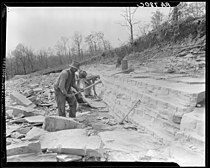The Cumberland Plateau of Tennessee is a stonemason's paradise. Rising over a thousand feet above the surrounding areas the plateau is virtually a never ending supply of beautiful stone.

Comprised of sandstone of the Mississipian and Pennsylvanian periods (geologically speaking). The vast, uninterrupted hardwood forests are shot through with dramatic gorges, cliffs, outcroppings, and waterfalls. Rolling hills can suddenly turn into steeps gulfs created by years of erosion. The area feels very mountainous but is actually a deeply dissected area of uplift. This is why all of the mountain "peaks" have roughly the same elevation.
Out of these abundant natural stone formations are millions of tons of rock to build with! The early settlers of the region were quick to take advantage of this. Building foundations and chimneys for their cabins that still stand to this day. Every time I see ruins of an old homestead I stop and think about the builder. How long did it take him to gather the stones? How did he transport them? What kind of mortar mix did he use? How frustrated did he get trying to keep things plumb and fit them all together? Who taught him how to build?

Every chimney or wall tells a story. An incredible amount of time and effort is put into stonework no matter who is doing it. All in a time before pre-bagged mortar mixes, electric mixers and home depot. I have a lot of respect for the old timers. Evidence of this early work can be found in many state parks and natural areas that were once privately owned.
Later in history the local stone would gain more prominence as architects and builders sought to use it in commercial projects. Quarrying began intensifying in the 20's when architects like Henry C. Hibbs needed stone for large projects like Southwestern University (now known as Rhodes College) in Memphis.

In 1930's the Cumberland County homesteads were built near Crossville. Homes that I consider to be some of the finest examples of the mortared fieldstone style. This was one of the WPA projects, and an ambitious one at that. The land was "given" to the locals for them to build houses on and then live in a sort of planned community, although they were required to work and pay back the government later on. With mixed success the federal government eventually ended their involvement in 1946, but the homes remain a shining example of Tennessee stonework. I may write a whole other blog post about this specific period of time because it is quite interesting and produced some of the best stonework all across the country.
The Cumberland Plateau is a region rich with history and some incredible stonework. With a natural resource in such abundance, its no wonder there are so many examples. I'm proud to be able to continue the legacy and keep producing work that will be around for many generations. I will continue to explore and document the local stonework in an attempt to digitally broaden the appreciation for this ancient craft.





Comments